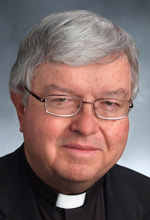Q. Why do we permit and even encourage distractions at the most solemn times in the Mass? Soon after the consecration, we invite people to converse with one another at the sign of peace, which I believe should come much earlier in the eucharistic celebration.
Then we ask them to sing during the distribution of holy Communion. (What could be more distracting than having to carry a song book up the Communion aisle — or hearing the fellow behind you singing wildly out of tune?) Why not keep this period a “quiet time,” as a sign of our deep reverence for the presence of Jesus in the sacrament? (Following Communion, after the Eucharist has been returned to the tabernacle, we could then sing a celebratory hymn of thanksgiving.) (The Bahamas)
A. In June 2014, following lengthy discussion, the Vatican issued a letter determining that the sign of peace should remain in the Mass where it had traditionally been placed. It had been thought by some that this exchange might better be placed earlier in the Mass, prior to the presentation of the gifts, and that possibility was given serious consideration.
[hotblock]
But the letter, issued by the Congregation for Divine Worship, explained that the present positioning highlights the unity of the congregation as it prepares to receive the body and blood of Christ. Interestingly though, the letter did advert to the danger you discussed: that the motion and conversation during sign of peace could prove distracting.
To minimize that concern, the letter notes among other cautions that the faithful should not move about while exchanging the sign and that the priest should not leave the altar to greet members of the congregation. In addition, during ceremonies such as weddings and funerals, the greeting should not become the occasion for congratulations and condolences, the letter said.
When it comes to singing during the distribution of Communion, the General Instruction of the Roman Missal does say (in No. 86) that the Communion chant is “to express the spiritual union of the communicants by means of the unity of their voices” as they process to receive the Eucharist.
I would think that the chant should be a familiar one, simply sung, so that hymn books would not have to be carried to the altar. Also to your point, the General Instruction of the Roman Missal, in No. 88, notes that “when the distribution of Communion is over, if appropriate, the priest and the faithful pray quietly for some time.”
Q. In the Canon of the Mass, we honor the saints Linus, Cletus, Clement, Sixtus, Cornelius, Cyprian, Lawrence, Chrysogonus, John and Paul, Cosmas and Damian.
The church recognizes more than 8,000 saints, many of whom are much better-known than that list in the Canon. Couldn’t we draw more inspiration from saints whom we know a bit about — perhaps St. Francis of Assisi, St. Patrick, St. Anthony of Padua, St. Therese of Lisieux, St. Teresa of Avila, St. Joan of Arc, St. Clare, St. Augustine, St. Bernadette, St. Thomas Aquinas, St. Catherine of Siena, St. Benedict or St. Padre Pio? (Woodbridge, Virginia)
A. The Canon of the Mass to which you refer is the first of four general eucharistic prayers in the Roman Missal from which the priest may select. More commonly called Eucharistic Prayer 1, it is also known by its former title, “the Roman Canon,” and it served as the only eucharistic prayer in the Roman rite for more than a thousand years.
It mentions, first, several of our best-known saints (Mary and Joseph, Peter, Paul and Andrew) before listing in parentheses a list of 21 saints that the priest may add if he so chooses. That longer list includes the saints you mention, who — naturally, given the prayer’s early origin — come from the church’s first few centuries. (Linus, Cletus, Clement, Sixtus and Cornelius, for example, were martyred popes.) My experience is that Eucharistic Prayer 1 is not used often and, when it is, the priest celebrant rarely opts to name the saints on the longer list.
Only the third eucharistic prayer specifically gives to the priest the option of adding other saints — the saint whose feast is being celebrated, perhaps, or the patron saint of the parish — but my sense is that celebrants sometimes choose to do this regardless of which of the eucharistic prayers they have chosen.
I agree with you that greater attention should be given to saints, particularly the more contemporary ones. In our parish, I typically give a 90-second talk at the beginning of weekday Mass about the particular saint whose feast we are marking. They are our heroes in the faith, and we ought to keep their example in front of us.
***
Questions may be sent to Father Kenneth Doyle at askfatherdoyle@gmail.com and 40 Hopewell St. Albany, N.Y. 12208.
PREVIOUS: See Pope Francis’ message for Lent 2016
NEXT: Prayers, care for sick are common ground for believers, pope says




Our Parish easily solved the socializing problem during the sign of peace by the Cantor going to the microphone, welcoming everyone to Mass, and then having everyone stand and greet their neighbors before the start of the Mass procession. As a result, the sign of peace became much more orderly, quiet and reverential.
someone should reprint the letter from the 1st question and gave it to most priests who come off the altar and chant with people as they exchange the sign of peace. This is the type of disobedience that preceded the protestant reformation. priests doing whatever they feel like in violation of Canon Law or other instructions!!!!!
The was never a sign of peace during the Latin Mass. It is most distracting and ill-placed. There is absolutely no need for it during Mass…we do enough socializing and community building every other day of the week. Can’t we give God 2 minutes of silence. RIDICULOUS!!! I prefer the Traditional Mass where you don’t have to high five someone after the consecration.